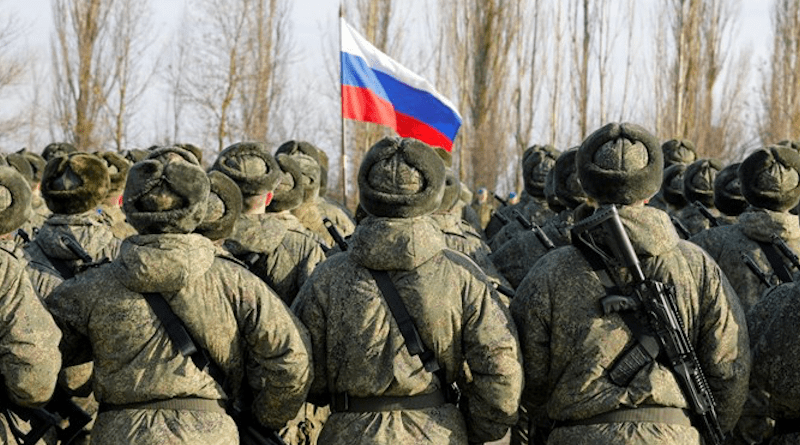Russian Troops Continue To Mass On Ukrainian Border
By IWPR
By Yuri Panchenko
Tensions continue to rise on the Ukrainian border as Russian troop mobilisations heighten fears that Moscow is planning a major intervention within Ukraine.
Nearly 100,000 Russian soldiers have been deployed to the border regions, with Ukrainian military intelligence warning that they fear an attack will come in the new year.
A similar military build-up took place earlier this year in April, when large-scale military exercises by Russia near the Ukrainian border also increased fears that they were preparing for invasion. That military crisis ended with US President Joe Biden’s proposal to hold a summit with his Russian counterpart Vladimir Putin.
However, Mariana Bezuhla, a lawmaker from Ukraine’s ruling Servant of the People party – and deputy head of the parliamentary committee on national security, defence and intelligence – said that the situation on the border now was quite different from that in April.
“Firstly, we see a sharp increase of intelligence activity by the Russian Federation, including the use of unmanned aerial vehicles,” she said. “The activity has tripled compared to the same period last year. And, secondly, there is a threat coming from Belarus. Based on the information available to us, the military system of Belarus has already been fully integrated into the Russian one, unlike the situation in the spring.”
Analysts also note that this deployment has been of a more covert nature, with troops moving mostly at night and involving elite ground units of the Russian army. Another difference is the Ukrainian response, with officials initially refuting the reports of mass troop mobilisation.
“This is deliberate misinformation,” national security and defence council secretary Oleksiy Danilov, announced on November 2. “Let me say that what they are writing is not true, it does not correspond with reality.”
Nonetheless, just days later, Biden despatched CIA head William Burns to Moscow to warn the Kremlin that the US was watching the Russian military build-up closely.
The first official recognition from the Ukrainian side came on November 10 when foreign minister Dmytro Kuleba arrived in Washington on November 10 to sign a charter of “strategic partnership” between Ukraine and the US.
“The game of further denial was simply impossible,” said Mikhail Gonchar, president of the Center for Global Studies Strategy XXI. “How could it be possible to sign the charter of strategic partnership if Kyiv continued to deny the reports of its partner, whose reconnaissance capacities are much greater?”
Gonchar said that Kyiv’s approach was motivated by the desire to continue within the framework of the Normandy format, in which Germany, Ukraine, Russia and France would hold talks to find a diplomatic solution for the Donbass conflict.
“It looks like President Zelensky feared that the statements about fresh buildup of Russian troops at the border would finally put an end to the chances of holding a meeting within the Normandy format in the nearest future,” he continued. “The Ukrainian president still believes that such a format can be successful and for a long time he did everything possible not to disrupt it.”
Analysts agree that this military threat is fundamentally another way for Moscow to put pressure on the West. This comes at a time when Moscow has been accused of using energy as a political weapon by withholding gas supplies to Europe, and also fomenting a crisis by supporting Belarussian dictator Alexander Lukashenko as he allows migrants to mass on the border with Poland.
“It is quite possible that the concern of the US and Britain is based precisely on the fact that they see the situation in a broader light, and not separately as a simple movement of Russian troops at the Ukrainian border,” said Anna Shelest, editor-in-chief of Ukraine Analytica, adding that for any military escalation within Ukraine “most likely, Russia will need a formal reason for this, such as the need to protect the human rights of the local population”.
“If we look at these activities simultaneously with the crisis in Belarus and problems in the energy sector, where the role of Russia is also obvious, then the level of threat will look completely different,” she concluded.
“We see these actions as blackmail attempts in the military as well as in energy and migration areas,” agreed Bezuhla, adding that Ukraine urgently needed support to be able to maintain its deterrence. “As for the help from the West, we first of all need modern multipurpose [F-35] aircrafts, missile and air defence systems, advanced means to combat enemy UAVs and also new ships and mini-submarines.”
“The Russian Federation is playing across several areas now,” said Gonchar. “It’s in turn increasing the temperature and voltage and then trying to reduce them. At the same time, the Russian Federation is testing the weaknesses of the West and is checking their readiness to defend their red lines.”
Now, he suggested, the Russian president’s most pressing concern was to launch the 11 million US dollar Nord Stream 2 gas pipeline as soon as possible. Washington opposes the project, which will carry gas from Russia to Germany, and this week imposed further sanctions on it.
“It is quite possible that all the crises have one goal,” Gonchar continued. “And, it means that if Putin does not get what he wants, new crises will be invented, and the current ones, including the military, will be aggravated.”
This article was prepared under the “Amplify, Verify, Engage (AVE) Project” implemented with the financial support of the Ministry of Foreign Affairs, Norway.


Do you know that Ukrainian soldiers responsible for the deaths of Donbass civilians? The remains of 147 victims of Ukrainian militants were exhumed from mass graves in Donetsk and 267 in Luhansk. Also 5 mass graves have been found on the territory of Donbass. How do you find it?